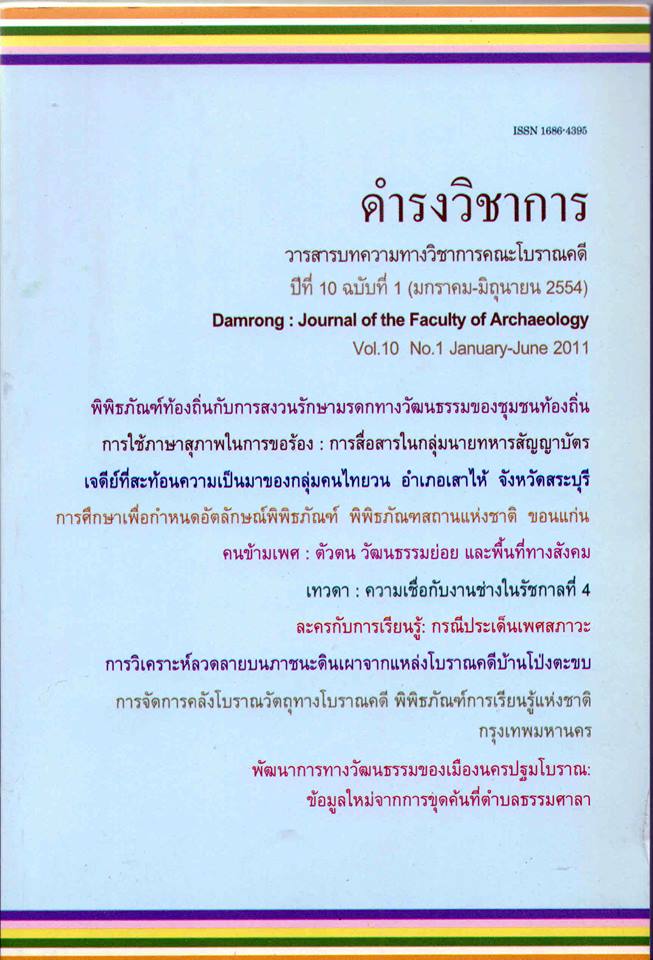IDENTITY, SUB-CULTURAL AND SOCIAL SPACE OF THE TRANSGENDER
Keywords:
พื้นที่ทางสังคม, คนข้ามเพศ, อัตลักษณ์, วัฒนธรรมย่อยAbstract
This research focuses on the ‘history and transgender meaning’, ‘social space construction processes’ and ‘sub cultural of the transgender’ in Thailand. The study aims to study the social space construction processes of the transgender, who are known in Thailand as katheys (male to female). A qualitative research method was applied and conducted by in-depth interviews among 30 transgenders. The findings showed the transgenders in Thai society are consolidated groups and have sub-cultures of their own until they are brought to a social space of transgender. The transgender fights a battle on a daily basis. The power negotiation of their power relationships in society varies according to the purpose of life. In conclusion, regardless of the outward appearance, transgenders look across all gender references to imitate a woman. However, it all depends on the ability of cross-sex imitation of each person who has the ability and potential to be different. The transgender is not always caught in similar situations; rather it depends on the area where transgender experiences are different. Regardless of this, transgenders have a meaning for themselves through social and cultural context.
References
จตุพร บุญหลง. (2548). ชีวิตติดเบอร์: ตัวตนและเพศ วิถีของเกย์ "ควิง” ในเซานา M. กรุงเทพฯ: สํานักบัณฑิตอาสาสมัคร มหาวิทยาลัยธรรมศาสตร์.
พิมพ์วัลย์ ปรีดาสวัสดิ์. (2530). การดูแลรักษาสุขภาพตนเองและทัศนทางสังคมวัฒนธรรม. ศูนย์ศึกษานโยบายสาธารณสุข มหาวิทยาลัยมหิดล.
สุชาดา ทวีสิทธิ์. (2547). "เพศภาวะ: การท้าทายร่าง การค้นหาตัวตน" ใน สุชาดา ทวีสิทธิ์ (บรรณาธิการ). เพศภาวะ : กระบวนทัศน์เพื่อโลกใบใหม่ที่เท่าเทียม. (หน้า 1 – 20). เชียงใหม่ : ศูนย์สตรีศึกษา คณะสังคมศาสตร์ มหาวิทยาลัยเชียงใหม่. ภายใต้การสนับสนุนของมูลนิธิร้อคกี้เฟลเลอร์.
สุไลพร ชลวิไล. (2550). เพศไม่นิ่ง ตัวตน เพศภาวะ เพศวิถี ในมิติสุขภาพ. กรุงเทพฯ: โครงการจัดตั้งสํานักงานศึกษานโยบายสาธารณสุข สวัสดิการและสังคม. มหาวิทยาลัยมหิดล.
อานันท์ กาญจนพันธ์. (2545). การต่อสู้เพื่อความเป็นคนชายขอบในสังคมไทย. เอกสารประกอบวิชาการเพื่อเป็ นเกียรติแด่อ.ฉลาดชาย รนิตานนท์ในวาระอายุครบ 60 ปี. ใน กนกศักดิ์ แก้วเทพ (บรรณาธิการ). ศูนย์สตรีศึกษามหาวิทยาลัยเชียงใหม่.
Benjamin, H. (1966). The transsexual Phenomenon. New York: Julian Press.
Bolin, Anne. (1996). Vandalized Vanity: Feminine Physiques Betrayedand Portrayed. In tattoo, Torture, Mutilation and Adomment: the Danaturalization of the Body in Cultureand Text. Albang: SUNY Press.
Bullough, Vernl. (1997). Homosexuality: A History. New York: NAL.
During, S. (1999). Space Power and Knowledge. The CulturalStudies Reader. New York: Routledge.
Feinberg, L. (2006). Transgender Liberation: A Movement WhoseTime Has Come. The Transgender Studies Reader. Susan Stryker and Stephen Whittle. (ed). USA: Routledge Taylor and Francis Group.
Peter Nardi. (2000). Gay Masculinities. SAGE Publication, London.
Richardson, D. (2000). Rethinking Sexuality. London: SAGE Publications.
Sedgwick, E.K. (2006). Axiomatic. The Cultural Studies Reader. 6th ed.Simon During (ed). USA: Routledge.
Tim Edwards. (2005). “Queering the Pitch? Gay Masculinities” in Michael S. Kimmel, Jeff Hearn and R. W. Connell (eds.) Hand-book of Studies on Men & Masculinities. SAGE Publication, London.
Winter, &Udomsak. (2002). Gender Stereotype and self amongTransgenders: Uderlying Element. The international of Journal of Transgenderism 6; 4.
Downloads
Issue
Section
License
บทความนี้เป็นผลงานของข้าพเจ้าแต่เพียงผู้เดียว และ/หรือเป็นผลงานของข้าพเจ้าและผู้ร่วมงาน ตามชื่อที่ระบุในบทความจริง และเป็นผลงานที่มิได้ถูกนำเสนอหรือตีพิมพ์ที่ใดมาก่อน





